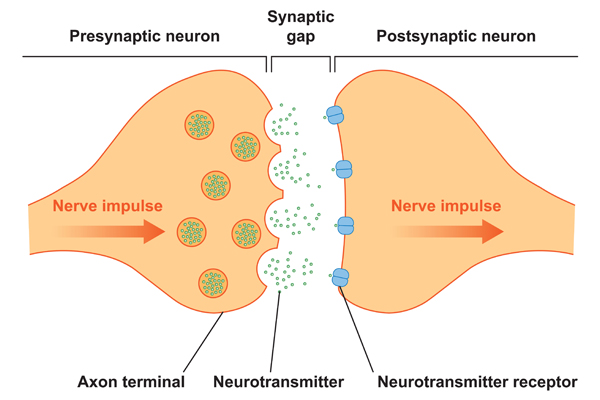I find it fascinating, the way our brains work. The brain contains billions of nerve cells and each of these cells talks to thousands of others. But how do they communicate? The answer is that they send each other messages across a special junction between them. The junction between two nerve cells is known as a synapse.
There are three parts to a nerve cell synapse. The first nerve cell has an area known as the ‘end plate’. This is where the message is being sent from. The second nerve cell has an area made up of ‘neuro-receptors’ whose job it is to listen to messages being sent. The third part of the synapse is the gap between these two areas which is called the ‘synaptic gap’.
For a signal to be transmitted, an electrical impulse runs down the outside of the first nerve cell until it reaches the end plate. Here it triggers the end plate to release molecules of a chemical called a neurotransmitter. When enough of these neurotransmitter molecules have drifted across the synaptic gap and attached to the receptors on the second nerve cell, this triggers the release of an electrical impulse down the second nerve cell. That’s the way all nerve connections work.
Now, there’s an interesting aspect to this. The more frequently a synapse is used, the closer the two nerve cells become. As the synaptic gap gets narrower, so it becomes easier for the neurotransmitter molecules to cross it and therefore easier for signals to travel between the two nerve cells. This effect is known as neural plasticity. It explains how we learn things like playing a musical instrument; the more we practice the easier it is for the nerve messages to flow. It also explains how we develop habits. Our brains develop deeply ingrained neural pathways that are easily triggered and set off fixed responses.

This is where the P-word comes in. Every time we encounter the word ‘pain’ we trigger pathways in our brain related to the feeling of pain. Due to neural plasticity it becomes progressively easier to trigger those pathways multiple times and hence for us to experience pain. Amazingly even the term ‘pain-free’ makes our brain first trigger pain pathways before it has time to think about the opposite. So just thinking about being ‘pain-free’ can actually make it easier to experience pain!
Here’s the clever thing though. We can also use this phenomenon to our advantage. I very rarely use the P-word when I am talking with my patients. I prefer to use the words ‘discomfort’ and ‘uncomfortable’. In this way we encourage the brain to trigger pathways associated with ‘comfort’ and ‘comfortable’ before it can think of the reverse. Just using those words helps to reinforce these pathways, making it easier to be comfortable. My job is to make it easier for my patients to be comfortable and help them towards health.
That is why I avoid the P-word.

